Search
To search for an exact match, type the word or phrase you want in quotation marks.
A*DESK has been offering since 2002 contents about criticism and contemporary art. A*DESK has become consolidated thanks to all those who have believed in the project, all those who have followed us, debating, participating and collaborating. Many people have collaborated with A*DESK, and continue to do so. Their efforts, knowledge and belief in the project are what make it grow internationally. At A*DESK we have also generated work for over one hundred professionals in culture, from small collaborations with reviews and classes, to more prolonged and intense collaborations.
At A*DESK we believe in the need for free and universal access to culture and knowledge. We want to carry on being independent, remaining open to more ideas and opinions. If you believe in A*DESK, we need your backing to be able to continue. You can now participate in the project by supporting it. You can choose how much you want to contribute to the project.
You can decide how much you want to bring to the project.

In 2009 the artist Juan López inaugurated the exhibition “Catalonia is hot Spain” at the NoguerasBlanchard gallery in Barcelona. The installation converted the space, with vinyl and insulation tape, into a swimming pool, with a video-projection showing a swimmer just about to dive into the water, something he never quite decides to do.
Lately, each time I talk to someone from outside Catalonia, the first issues to arise, before any sort of conversation, are either Barça’s latest victory, or the question of independence. Normally I move quickly on without pausing on them for too long. But inevitably it seems at the moment it’s a hot subject.
But let’s take it bit by bit. The idea of this text is to reflect, in a totally subjective manner, on the political process taking place at the moment, regarding the articulation of Catalonia and the Spanish State, and the place that culture, and more specifically creation and contemporary thought, can have in all this. The reflection arises based on examples of works by some artists who touch on the question – albeit tangentially-.
To begin with, is it possible to understand the Catalan question without bearing in mind the Spanish state, without understanding its diversity, plurality and the wealth of culture that it possesses, but also the complex coexistence that all this brings with it? It’s vital to evaluate the historic processes which precede the current paradigm, the Spanish transition urgently needs revisited, in order to move forward once and for all from the bases that were established in 1978. The Spanish State is a mosaic of regions with distinct histories, languages and cultures, and their articulation within the coexistence of the State has always been complex. We could go back as far as the era of the Catholic kings…but this isn’t the right place, nor am I the one to do so. After a civil war and more than 30 years of dictatorship, the Transition was a process hemmed in by the very complex, specific and defining circumstances in which the Constitution of 78 was written, that established the bases for the coexistence of the Spanish State by which we are governed in the present day. Something that can’t have been an easy task, as a minimum of consensus had to be reached amongst all the parties involved, from the ministers of Franco converted into democrats, to the communists who were returning from exile.
Years which, in the last few decades, have been hard to approach with a critical spirit. Contemporary art has been no exception, with only a few artists trying, although in the last few years the dynamic seems to be changing, with younger artists approaching without prejudices an era that is crucial when deciphering the current territorial structure. The unstable equilibrium upon which essential issues are based are made explicit in “History as a Story”, a piece by Fran Meana in which he arranges a series of archival photographs from that time, one on top of the other, in chronological order. The funeral of Franco is at the base, at the top Adolfo Suárez drying the sweat from his brow. In between, some scenes that belie the seriousness that one bestows upon them.

For its part, “Carmen”, by Lúa Coderch, shows an image of Carmen Polo, the dictator’s widow, voting in the Referendum of 1976, the symbolic beginning of the Spanish democracy, alongside an audio-essay that relates in a precise manner how to establish a “polyarchy by gradual emancipation”. The piece also refers to the period of transition, “a process that has been attributed for a long time with a high degree of consensus and legitimacy, being in any case, the process which established the bases for the present parliamentary monarchy. Without trauma, rupture or conflict: what is usually called an “exemplary” transition, with which they want to say untouchable, or unsullyable.”
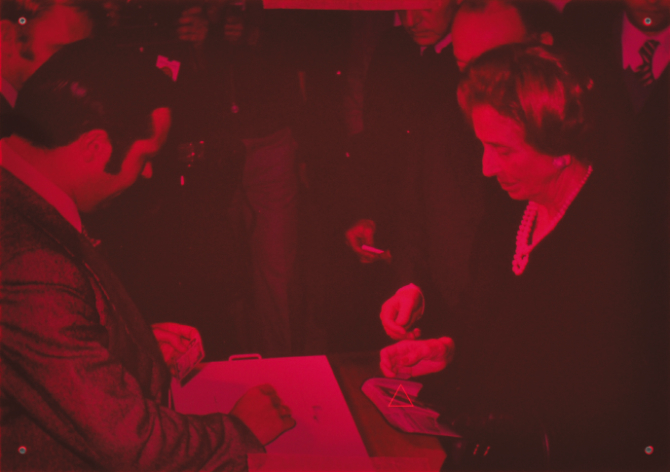
Both pieces suggest that it maybe wasn’t quite as clean as we were told at school, that there are many grey areas, open wounds and aspects to be discussed and reconsidered, leaving aside the stereotypical and established stances, the quasi “dogmas of faith” upon which many of the current, territorial, political discourses are established. There are more than enough reasons to reconsider different aspects of the Constitution – of which one is the territorial question-, and at this point we ought to be in a position to evolve and come to agreements and structures that are more in accord with our times. After all, when it’s a case of changing the economic rules of the game –to save the banks-they can be modified.
And why not think that contemporary art could offer a valuable space here in which to imagine possible alternatives for the future? In the end, art and artists represent a possibility to change structures of thought, to think and feel in different ways.
In some areas the perception exists that the process that is occurring on a political level responds more to a series of party, electoral and economic interests and strategies, than to the real desire of those governing to articulate a process for independence in Catalonia. In this sense, and with the intention of specifying the movements of those in power, in December 2012, the “Grupo Información” was set up in Barcelona, composed of Efrén Álvarez and Antonio Gagliano. Invited to participate in an exhibition programme in the Espai Cultural Caja Madrid, the artists set in motion a far-reaching project “with the perspective of activating the development of ascending systems of control on the powers that be in our society, deploying techniques suited to our times, (…) We want to explore new narrative limits for data, proposing ethics of privacy and intimacy (…). We’re interested in promoting new forms for the compilation, connection and presentation of public information, whether it has appeared officially or in the press, to confirm, as much as we can, the well known secrets of Western democracy.”
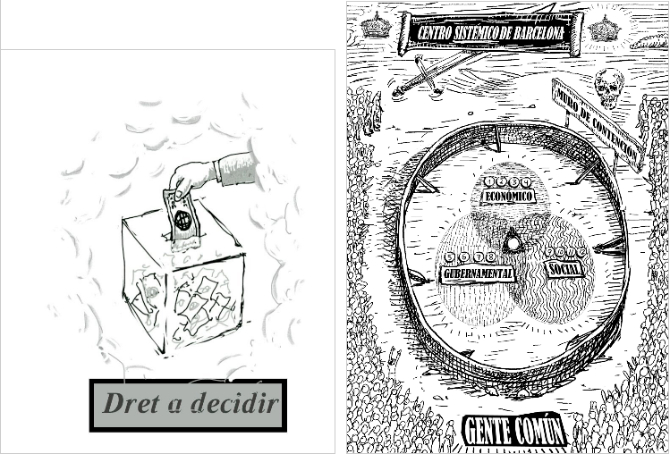
With the exhibition project having been censored in the Caja Madrid space, they published the fanzine “La Catalunya Triomfant”, that unveils a series of instruments of communication related to the controversy. “Sensationalism, like caricature’s capacity for contagion, can end up on occasion being an unbeatable technical tool”, they state. In this way they articulate a stroll through the political centre of Catalonia, “as if informing some supposed tourists, from a distant country that had managed to liberate itself from the barbaric spectacle of the culture of capital, in the face of their perplexity about the absurd government of money.” The fanzine covers a fantastic, mythical journey that serves as a point of departure for its aims, highlighting and indicating without clemency in whose hands the power lies.
The same mythical and epic element, inherent in certain aspects of the story of the national cause, serves as a catalyst for the work of some other artists.

Quim Packard elaborates in some of his drawings an “epically absurd but romantically beautiful” vision, simulating the idea of liberty and the struggle for autonomy with certain videogames, such as Final Fantasy III –which is said to be a metaphor for America’s colonial invasion of Japan-. Faced with the confirmation that Catalan nationalism doesn’t coexist very happily with the sector of the visual arts (a while ago, an important Barcelona gallerist declared that “Contemporary art doesn’t speak Catalan, which is why they don’t pay us any attention”), one solution is to make drawings that are unashamedly pro-Catalan.
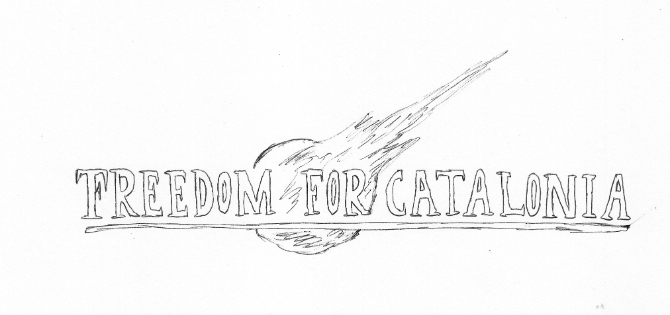
Epic is also the story that Antoni Hervas tells us in “Més que un club”. Hervas’ work talks of what’s close to hand, “through a fairly pop vision of the everyday, so that being from Barcelona and having lived here for most of the time means that, on sufficient occasions, places, traditions or Catalan symbols appear represented in my drawings and become epic scenarios where the narratives that I propose develop”. In this case, he explores the construction of heroism and sacred places by establishing contrasts between narratives of the present and the past, proposing the development of an investigation that he began while working as a photographer in the Barça Museum with the hypothesis that a copy of the Champions League cup of 92 could in fact be that of the Holy Grail. Medieval knights, football players, Barça fans, Montserrat and the museum itself are objects that are placed in relation with each other in this visual essay that deals with the persistence in the way certain forms of myths are constructed and the popular fervour of Catalan nationalism.

And talking of fervour, we could look at the video ”Tothom estima a Catalunya” that Ana García Pineda proposes, based on a commission from TV3, a few years ago, for a special for the Catalan National Day. “They asked me for a short piece that would refer to Catalan culture and which in some way paid homage to it. Everything to do with nationalism always provokes in me a certain scepticism. So, if I had to talk about it, it had to be with a sense of humour and irony; which when all is said and done, even if many forget it, preferring to take the matter too seriously, are characteristics that are very specific and thoroughly embedded within Catalan culture. Self-criticism, word games, pointed jokes…”. The video is a compilation of clues and evidence (with irony and sarcasm) of the huge respect that the region instils, by way of homages to the legend of the flag. The majority of them coming from Hollywood horror films, remembering the legendary landscape.
However, it wouldn’t be objective to affirm that the “senyera” and every scenario that it represents is a fallacy. Of course the people and the Catalan territory possess their own culture, language, history and identity, and we could even affirm that part of the population expresses a desire for independence. The problem –or one of them- lies in the use that the politicians make of this desire, appropriating it and using it to their own benefit. What sense is there in an independence that leads us to an identical scenario but with different frontiers?

And along these lines advances the development of another editorial project: the singular investigation into the historic process of Catalonia that David Bestué and Andrea Valdés develop in the collectable ““La línea sin fin”. “A project about Catalonia that goes from a boy fleeing criticism (1873) to the subsidised flights of Ryanair (2013). The idea is to revisit a century of events, establishing connections and temporal games in an ironic and literary way and in this way, rescue common references and places that help us to understand the present”. A limited edition in six instalments, the first of which begins with the setting up of a factory and ends with the Tragic Week. Bestué and Valdés position themselves critically with regard to some of the uses to which Catalan culture has been put by different governments, but aware of their importance and pertinence to a territory and a tradition, they want to generate a different story. “As far back as we can remember Catalonia has been a problem that has been discussed a lot, so much so that it now leaves us cold. Maybe because it has always been talked about in the same way, invoking its battles, defeats and differences. So much protection of its culture has institutionalised it, making it into a norm. (…) Even at the risk of exposing ourselves to a resounding failure, we believe that it’s worth losing respect for this place, our place, to talk about it without fear of offending it. Otherwise, we’ll end up asleep, just when our body demands quite the opposite. We are awake.”
On the other hand, if we think about this whole process, another of the difficulties is that everything is taken to the extremes of black and white, for or against, making any greyness or nuances disappear, nuances that would be so important in its articulation. In these grey areas, in these non-archetypal positions is where Martí Ansón situates himself, talking about the need to recuperate small gestures, everyday processes and small structures, that are the ones that really create a society, and consequently identity; the need for debate and thought to be generated on this side and not in the wake of grand electoral slogans.
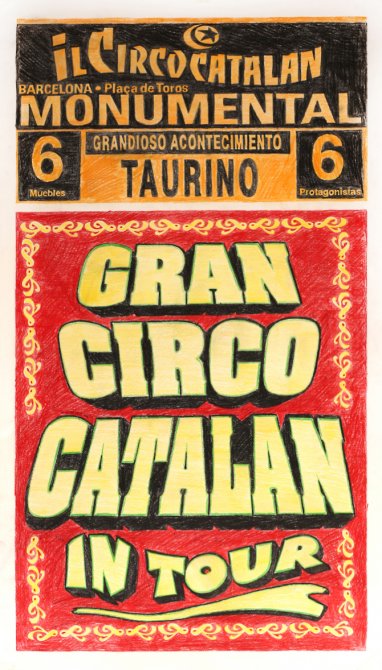
Along the same lines, in a conversation with the artist, Nuria Güell we commented that, beyond the promises of the various sides, she believes “in the different cooperative initiatives that have multiplied over the last few years in the Catalan territory, based on popular self-organization, a maxim that our great-grandfathers left us as our heritage”. It is in this sense, that she set up, along with a group of friends, the “Cooperativa Integral Catalana” in her town: a cultural cooperative that seeks social transformation from the bottom up, through self-management, self-organisation and working in a network. They occupied, for their headquarters, “a factory that had been abandoned for 30 years, remodelling it so as to be able to use it as the cooperative’s headquarters in order to carry out different cultural activities for the people in the town.” [1]
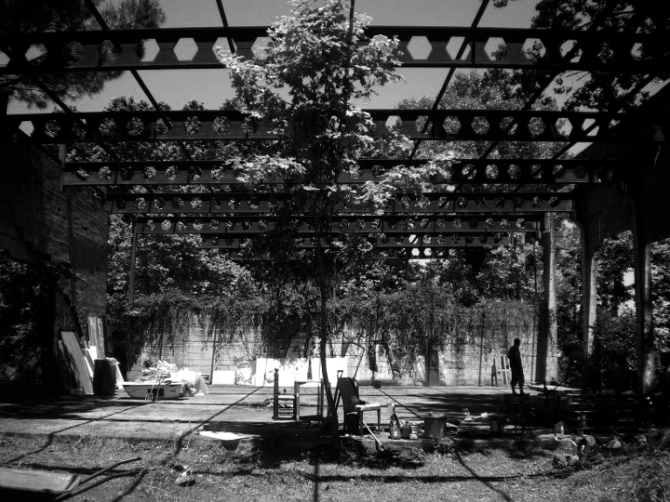
These personal, non-establishment postures, far removed from stereotypes and political franchises, are the ones that can enrich the discourse, and perhaps that is where art and contemporary thought can play their part.
As far as the territorial question in itself is concerned, the cultural producer Oscar Abril Ascaso has been developing, since 2010, the performance project “Acción Ibérica”, a “research project into the margins of the generation of political discourse with art actions, experimenting with the possibility of the lecture as a field for performance practices and as a device for political empowerment.” “Acción Ibérica” has celebrated diverse meetings in various cities, with each one of these political acts being aimed at creating an affinity group for direct action, to foment Iberianism, understanding the contentious issue of the Iberian territory as a question relating to the multinational dimension of its territory and as such defending an Iberian Union, understood as a free confederation of Iberian nations.

Ascaso sets in motion a device that, through performance, structures distinct political avenues for reflection and action around the territorial question in the Iberian Peninsula.
What seems fairly evident is that the old concept of the nation-state is becoming fairly obsolete in a world that every day is more global, where the flux of knowledge and people is ever more porous, with some advocating the possibility that a critical regionalism could have more meaning in the 21st century. Peio Aguirre a while ago talked about a Europe of Regions, as that “supranational entity and also as the realization of a utopia in which the Basque country, Galicia, Catalonia, Brittany, Saxony, Wallonia, Flanders, Tyrol or Wales (to give only a few examples) could establish a relation of equal vicinity as a new judicial category: the Euro-region.” But he also contemplated a diatopical scenario, in which they all became independent, where Europe could seem like a medieval scenario of technocratic clans.
Personally, I incline towards the possibility of imagining new forms of relating to each other, between humanity itself as much as with other nonhuman agents, such as the natural environment that is specific to each place. Here is where art could have the potential to propose new forms of agency, and these would be what could generate other spaces for coexistence and also propitiate new forms of relation between some communities and others. Far removed from this State proportioned by the politicians and governed by the economic interests of only a few. We shouldn’t care a jot whether the pool that those in government today throw themselves into is full of water or empty, but we should care a lot about imagining a new paradigm.
To end, I’m left with a few words of the post-anarchist philosopher, Michel Onfray: “the regions ought to love each other for reasons other than nationalism. We should impede the politicians from confiscating them and using them later to their benefit. One loves a region when one lives in it, when one works in it, when one remains in it, when one doesn’t denigrate it, when one doesn’t defend it just for its past, but for its potential: its present and its future. (…) One loves a region when on awakening one has no desire to see other landscapes; when one loves the lights and colours that brighten our day, the mists at dawn, the sounds of twilight (…) when one loves a geography, a geology: the perfumes of the earth -hill, pine forest, woods-, the volumes of a territory – the plain, mountain, coast, moor, cove-; when one listens with happiness to the tone, the inflection of a voice, the song of a language, of a pronunciation; not when the economic and administrative reins of that region are controlled, when the same hymn is sung in unison, when a firm stance is taken in front of one single flag. Lets leave all that to those who don’t love their region, but power.”

Juan Canela is chief curator is at the Museo de Arte Contemporáneo de Panamá. He works with artists and other people. He understands curatorial practice as a practice in which ideas, concepts and contents come into play, but also working structures, rhythms, models and ways of life. If it seems that there is no possible future, perhaps from here we can close our eyes and intuit one.
"A desk is a dangerous place from which to watch the world" (John Le Carré)